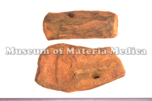Rhubarb

|
Market name:ダイオウ Photo location:Museum of Materia Medica, Inst. of Nat. Med. TMPW No.:19929 |

|
Plant name:Rheum palmatum Photo location:Yunnan Prov., China Photo date:1996 Photographer:K. Komatsu |
| Synonym | |
| Latin name | Rhei Rhizoma |
| Botanical source: Family name | Polygonaceae |
| Botanical source: Plant name | - Rheum palmatum Linné (IPNI:696772-1) - Rheum tanguticum Maximowicz ex Balfour (IPNI:696803-1) - Rheum officinale Baillon (IPNI:696768-1) - Rheum coreanum Nakai (IPNI:696723-1) - their interspecific hybrids |
| Part used | Dried rhizome |
| Empirical criteria for quality selection | Good one has a characteristic golden yellow pattern and star-like spots. The internal part is stiff and contains oil with a clean aroma. It is sticky when chewed. (NI) |
| Constituents | Anthraquinones: Chrysophanol, Emodin, Rhein, Aloe-emodin, Physcion, Physcionmonoglucoside, Aloe-emodin-8-monoglucoside, Chrysophanol-1-monoglucoside, Emodin-monoglucoside, Rhein-8-monoglucoside, Sennidin A, Sennidin B, Sennidin C, Rheidin A, Rheidin B, Rheidin C, Palmidin A, Palmidin B, Palmidin C, Palmidin D, Sennoside A, Sennoside B, Sennoside C, Sennoside D, Sennoside E, Sennoside F, Dirhein, Anthrone, Chrysophanol anthrone, Rheinosides; and the following are metabolites: 8-Glucosylrheinanthrone, Rheinanthrone, Sennidin A-8-monoglucoside, Sennidin B-8-monoglucoside, Sennidin B-8'-monoglucoside, Rhein dianthrone diglucoside Tannins: Rhatannin I, Rhatannin II, Torachrysone 8-glucoside, 6-Hydroxymusizin, Lindleyin, Procyanidin B-1 3-O-gallate, (+)-Catechin, (-)-Epicatechin, Epicatechin gallate, Gallocatechin, Gallocatechin gallate, Glucogallin, 2'-O-Cinnamoylglucogallin, Gallic acid, Tetrarin; (-)-Epicatechin 3-O-gallate, Procyanidin B-2 3,3'-di-O-gallate, RGtannin; 1,2,6-Trigalloyl-glucose, 3-O-Galloylprocyanidin B-1 Stilbenes: Sect.Rhapontica, Sect.Ribesifornia: Rhaponticin, 3,5-Dihydroxy-4-methoxy stilbene glucoside, Piceid; 3,5,4'-Trihydroxystilbene 4'-glucoside and its 6''-O-gallate Naphthalenes: Torachrysone 8-glucoside, 6-Hydroxymusizin and its 6'-Ooxalate |
| Pharmacological effects | Cathartic [extract, rhubarb powder, sennoside A)]. Antibacterial (water extract, aloe-emodin), antifungal (catechin). Decreases urea nitrogen in the blood (rhatannin). Decreases MG level in the blood and the urine (water extract, epicatechin 3-O-gallate, procyanidin B-2 3,3'-di-O-gallate). Antiinflammatory, analgesic (lindleyin). Anticholera toxin (RG-tannin). |
| Indications | It is mild laxative and stomachic and removes blood stasis. In Chinese medicine, it is a key drug for ones with excess syndrome to remove poison, to promote bowel movement, to cure stomachache of constipation, and festering swelling. |
| Diseases | Constipation, Abdominal pain, High fever, Disturbance of consciousness, Diarrhea, Tenesmus, Full stomach, Chill, Red eye, Swelling and pain of the throat, Toothache, Nasal hemorrhage, Hematemesis, Appendicitis, Pyogenic dermatosis, Amenorrhea, Hyperemesis after childbirth |
| Formulas | inchinkoto , oshosan , otsujito , ompito , kagenryokakusan (asada) , kakkonkokato , kamigedokuto , kippidaiobokushoto , kyoseihatekigan , kumibinroto , keishikashakuyakudaioto , kobokusammotsuto , kobokushichimotsuto , gomotsugedokusan , saikokaryukotsuboreito , san'osan , san'oshashinto , shikonboreito , shakosaito , shakkan'oshimbuto , shojokito , shinsentaitsuko , jiketsujunchoto , junchoto , jingyobofuto , senkinkeimeisan , daioorenshashinto , daiokanzoto , daiobushito , daiobotampito , daikankyoto , daisaikoto , daijokito , choijokito , jidabokuippo , jizusoippo , tsudosan , teitoto , tokakujokito , toryuto , dokkatsuto , nyoshinsan , hachimisenkiho , hachimitaikaho , bushishashinto , bofutsushosan , mashiningan , ryokakusan |
| Meridian tropism | Spleen, Stomach, Large intestine, Pericardium |
| Property | Cold |
| Flavor | Bitter |
| Classification in "Shen-non Ben-cao Jing" | Inferior |
| TCM: Classification | Purgatives |
| TCM: Medicinal effects | Purging heat and loosening the bowels, clearing away heat in the blood and toxic materials, removing blood stasis and inducing menstruation.: For fever with constipation, retention of the feces and abdominal pain, dysentery with inadequate discharge from the bowels, jaundice caused by damp-heat, hematemesis, epistaxis, inflammation of eye and swelling of the throat, appendicitis with abdominal pain, boils, sores and abscess, amenorrhea due to blood stasis, traumatic injuries, hemorrhage from the upper gastrointestinal tract, burns. |
| Remarks | Listed in the Japanese Pharmacopoeia 18th ed. |
| References | NI: N. Isshiki, Methods of Quality Evaluation and Preparation of Wakan-yaku [Wakanyaku no ryohi kanbetsu-ho oyobi chosei-ho], Tohodo Shoten, Tokyo, 1987. |
DNA sequences of medicinal plants
| Gene Region | |||||||||||||||||||
| Nuclear | Chloroplast | Mitochondria | |||||||||||||||||
| Botanical source: Plant name | 5Ss | 18S | ITS1 | 5.8S | ITS2 | 26S | others | trnH-psbA | matK | trnK | trnK-rps16 | trnT-L | trnL | trnL-F | rbcL | rpoC1 | ndhF | others | |
|
|
|||||||||||||||||||
|
|
|||||||||||||||||||
|
|
|||||||||||||||||||
|
|
|||||||||||||||||||
